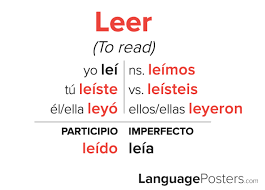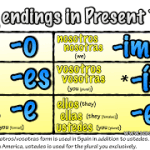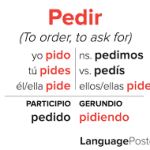Are you struggling to conjugate the verb ‘leer’ in Spanish? Don’t worry, we’ve got you covered! In this article, we’ll guide you through the different tenses and moods of ‘leer’, helping you master its conjugations.
From the present tense to the subjunctive mood, we’ll break it down step by step. Get ready to improve your Spanish skills and confidently use ‘leer’ in any conversation.
Let’s dive in!
Present Tense Conjugation of ‘Leer
To conjugate ‘leer’ in the present tense, you simply add the appropriate endings to the verb stem. The verb stem for ‘leer’ is ‘le-‘.
So to conjugate it, you’d add the endings -o, -es, -e, -emos, -éis, and -en to the stem.
For example, if you want to say ‘I read,’ you’d say ‘leo.’
If you want to say ‘you read,’ you’d say ‘lees.’
And if you want to say ‘they read,’ you’d say ‘leen.’
It’s important to note that the first person plural form, ‘we read,’ is irregular and is conjugated as ‘leemos.’
Past Tense Conjugation of ‘Leer
Now, let’s talk about the past tense conjugation of ‘leer’.
In the preterite form, ‘leer’ is irregular and changes slightly in its stem. However, the endings remain the same as regular -er verbs.
Here are some examples of how to use ‘leer’ in the past tense:
‘Leí un libro interesante’ (I read an interesting book)
‘Leíste el periódico ayer’ (You read the newspaper yesterday).
Preterite Form of ‘Leer
You learned how to conjugate ‘leer’ in the present tense, now let’s discuss how to form the preterite of ‘leer’. In the preterite tense, ‘leer’ undergoes some changes. Here are three important things to remember:
- The stem of ‘leer’ changes to ‘leí-‘ in the preterite tense for the first and third person singular forms.
- The endings for the preterite tense are different from the present tense. The endings for ‘leer’ in the preterite are ‘-í’, ‘-iste’, ‘-ió’, ‘-imos’, ‘-isteis’, and ‘-ieron’.
- Unlike regular -er/-ir verbs, ‘leer’ doesn’t have any accents in the preterite tense.
Irregularities in Conjugation
In the previous section, we covered the preterite form of ‘leer’. Now, let’s delve into the irregularities in conjugating ‘leer’ in the past tense.
When conjugating ‘leer’ in the past tense, there are no irregularities in the stem of the verb. However, there’s an irregularity in the endings that are used. Instead of the regular -er endings, ‘leer’ uses the -í endings.
For example, instead of saying ‘yo leí’ (I read), we say ‘yo leí’. The same pattern applies to the other pronouns: tú leíste, él/ella/usted leíó, nosotros/nosotras leímos, vosotros/vosotras leísteis, and ellos/ellas/ustedes leíeron.
Examples of Usage
To further illustrate the irregularities in conjugating ‘leer’ in the past tense, let’s explore some examples of its usage.
Here are a few instances where you can see how ‘leer’ changes in the past tense:
- Leí un libro interesante ayer. (I read an interesting book yesterday.)
- Leíste el periódico por la mañana. (You read the newspaper in the morning.)
- Leyó el poema en voz alta. (He/she read the poem out loud.)
These examples demonstrate the different conjugations of ‘leer’ in the past tense. As you can see, the endings change depending on the subject pronoun.
It’s important to remember these irregularities when using ‘leer’ in the past tense to accurately express past actions involving reading.
Future Tense Conjugation of ‘Leer
In the future tense, when you want to talk about reading in Spanish, you’ll need to conjugate the verb ‘leer’. The conjugation of ‘leer’ in the future tense is straightforward.
You simply need to add the appropriate endings to the verb stem ‘leer-‘ to match the subject pronoun.
Leer in Future Tense
You will conjugate the verb ‘leer’ in future tense by using the appropriate form of the verb ‘leerás’. In Spanish, the future tense is used to talk about actions that will happen in the future. When conjugating ‘leer’ in future tense, you’ll take the infinitive form ‘leer’ and add the endings -ás, -ás, -á, -emos, -éis, or -án, depending on the subject pronoun.
Here are three examples of conjugating ‘leer’ in future tense:
- Tú leerás (You will read)
- Él/Ella/Usted leerá (He/She/You formal will read)
- Nosotros/Nosotras leeremos (We will read)
Using the future tense allows you to express your intentions, make predictions, or talk about future plans involving the verb ‘leer’.
Conjugating Leer Futur
When conjugating ‘leer’ in future tense, you’ll use the appropriate form of the verb ‘leerás’.
In Spanish, the future tense is used to talk about actions that will happen in the future.
To conjugate ‘leer’ in future tense, simply add the appropriate ending to the verb stem.
For the second person singular, which is the form used when speaking directly to someone, you’ll add the ending ‘-ás’ to the verb ‘leer’.
So, the correct conjugation for ‘leer’ in future tense when addressing someone directly would be ‘leerás’.
This form is used when you want to say ‘You will read’.
It’s important to remember that in Spanish, the future tense is used less frequently than in English, and the present tense is often used to talk about future actions.
Future Tense of Leer
To conjugate ‘leer’ in future tense, simply add the appropriate ending to your verb stem. In the future tense, the verb stem for ‘leer’ remains the same, which is ‘leer’.
Here are the endings you need to add to the verb stem:
- Yo leeré (I will read)
- Tú leerás (You will read)
- Él/Ella/Usted leerá (He/She/You formal will read)
- Nosotros/Nosotras leeremos (We will read)
- Vosotros/Vosotras leeréis (You all will read)
- Ellos/Ellas/Ustedes leerán (They/You all formal will read)
These endings indicate who’s performing the action and when it will happen.
Now you can confidently talk about reading in the future tense in Spanish!
Imperfect Tense Conjugation of ‘Leer
During the imperfect tense, while you were reading, you’d say ‘leías’ in Spanish. The imperfect tense is used to talk about ongoing or repeated actions in the past.
When conjugating ‘leer’ in the imperfect tense, you’d use the second person singular form ‘leías’ to address someone directly.
For example, if you were speaking to a friend and saying ‘While you were reading, I was studying,’ you’d say ‘Mientras tú leías, yo estudiaba.’
The ‘ías’ ending is characteristic of the imperfect tense and it’s important to remember to use it when talking about past actions that were ongoing or repeated.
Conditional Tense Conjugation of ‘Leer
To discuss the conditional tense conjugation of ‘leer’ in Spanish, we continue our exploration of verb conjugation by addressing the hypothetical actions that could occur while reading.
- The conditional tense is used to express actions that would happen under certain conditions.
- Conjugating ‘leer’ in the conditional tense involves adding the endings -ía, -ías, -ía, -íamos, -íais, or -ían to the verb stem.
- For example, if you wanted to say ‘You would read,’ you’d say ‘Tú leerías.’
Using the conditional tense with ‘leer’ allows you to talk about the possibility of reading in hypothetical situations. Whether it’s imagining yourself reading a book on a beach or envisioning yourself reading a newspaper in a foreign language, the conditional tense helps you convey these hypothetical actions.
Subjunctive Mood Conjugation of ‘Leer
Now let’s dive into how to conjugate ‘leer’ in the subjunctive mood, which is used to express doubt, uncertainty, or subjectivity in relation to reading.
When it comes to the second person, singular form of ‘leer’ in the subjunctive mood, you’d say ‘leas.’ This form is used when there’s a need for doubt or uncertainty in a statement.
For example, if someone were to tell you to read a certain book, but you’re unsure if you’ll have time to do so, you can say ‘Es posible que tú leas el libro’ (It is possible that you read the book). In this case, ‘leas’ expresses doubt about your ability to read the book.
Frequently Asked Questions
What Are Some Common Phrases or Expressions That Use the Verb ‘Leer’ in Spanish?
Some common phrases or expressions that use the verb ‘leer’ in Spanish are “¿Lees mucho?” (Do you read a lot?), “Me gusta leer” (I like to read), and “Leo el periódico” (I read the newspaper).
Are There Any Irregularities or Exceptions in the Conjugation of ‘Leer’ in Any of the Tenses Mentioned?
In the conjugation of ‘leer’ in Spanish, there are no irregularities or exceptions in any of the tenses mentioned. You can easily conjugate this verb without any difficulties.
How Does the Verb ‘Leer’ Change When Used in the Formal or Polite Form of Address?
When using the formal or polite form of address with the verb ‘leer’ in Spanish, you simply add an ‘s’ to the end of the present tense conjugation. For example, ‘usted lee’ becomes ‘usted leeS’.
Can You Provide Examples of Sentences Using ‘Leer’ in Different Tenses to Illustrate Its Usage?
Sure, I can provide examples of sentences using ‘leer’ in different tenses to illustrate its usage. Just let me know which tenses you would like to see examples for.
Are There Any Regional Variations or Dialectal Differences in the Conjugation of ‘Leer’ in Different Spanish-Speaking Countries?
In different Spanish-speaking countries, there might be regional variations or dialectal differences in the conjugation of ‘leer’. It’s important to be aware of these variations to communicate effectively with native speakers.
Conclusion
In conclusion, conjugating the verb ‘leer’ in Spanish requires understanding the different tenses and moods.
The present tense conjugation of ‘leer’ is ‘leo’, the past tense is ‘leí’, the future tense is ‘leeré’, the imperfect tense is ‘leía’, and the conditional tense is ‘leería’.
In the subjunctive mood, the conjugation of ‘leer’ varies depending on the subject.
By practicing these conjugations, you’ll be able to use the verb ‘leer’ correctly in various contexts.


